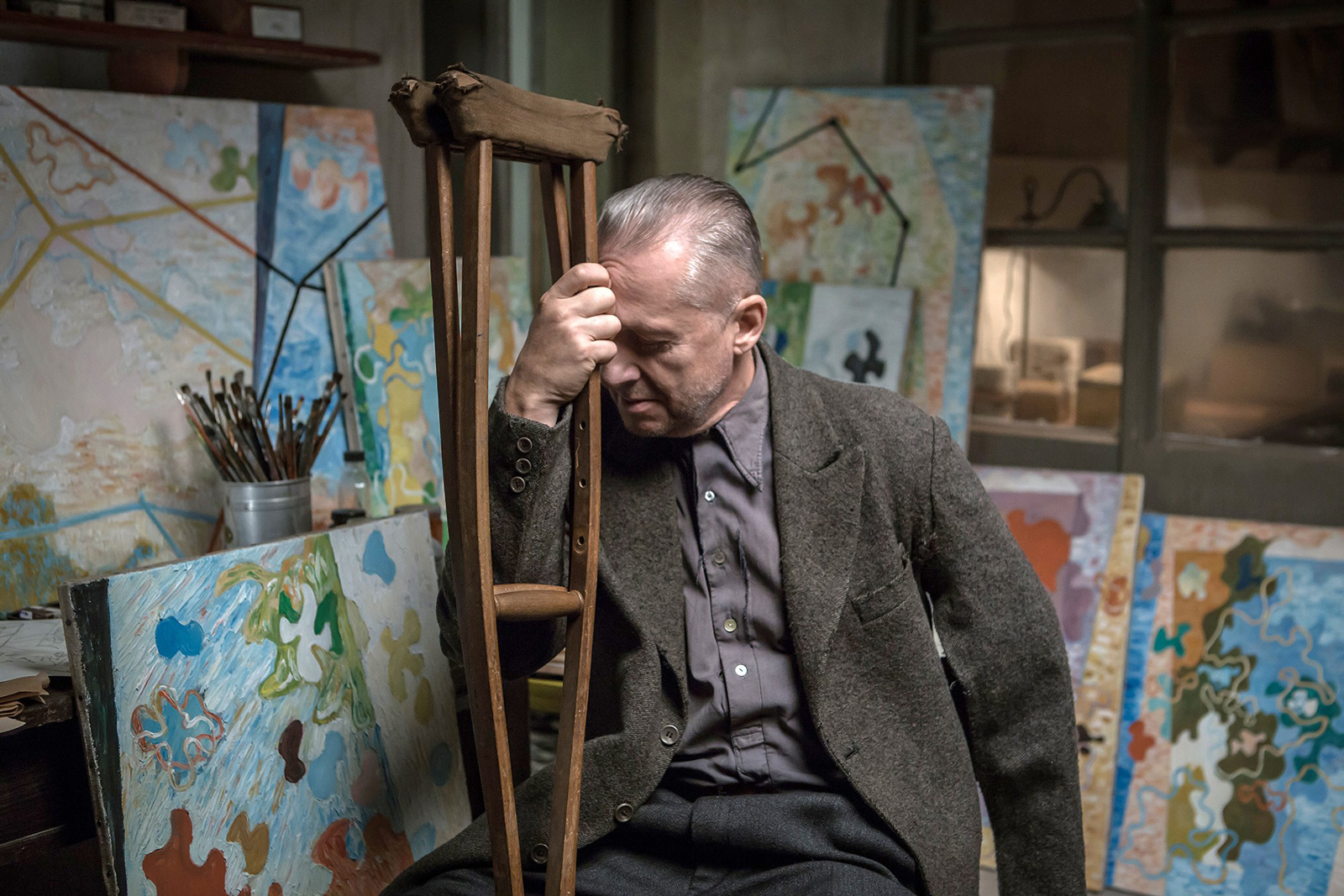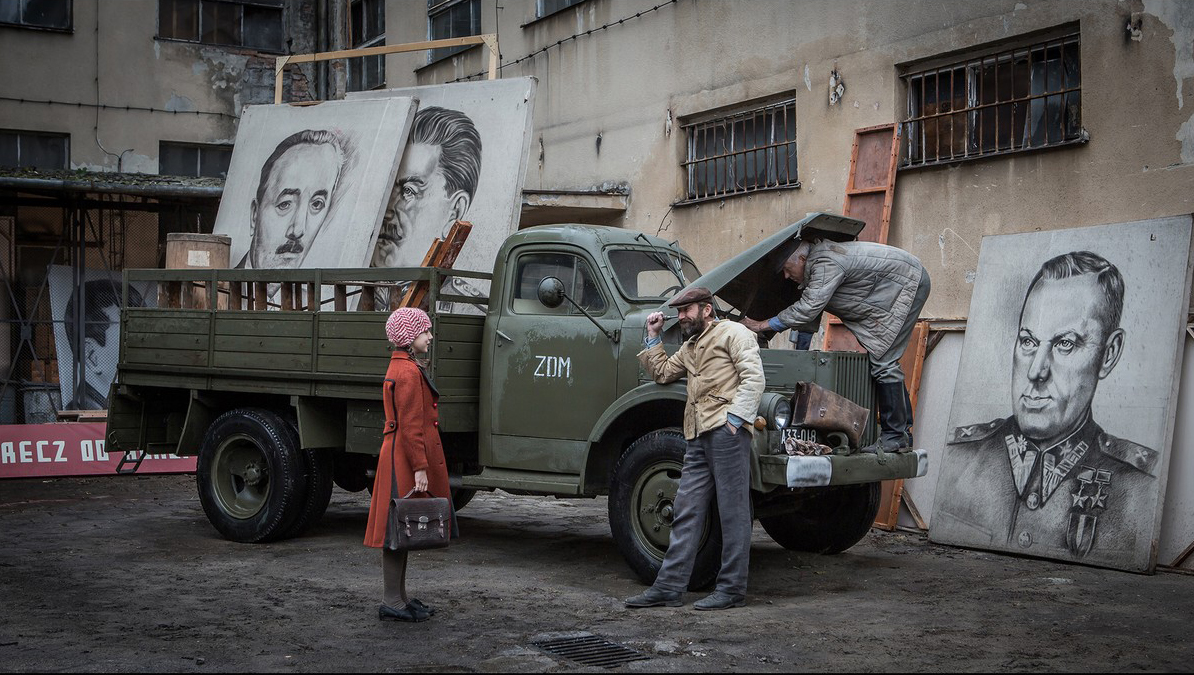Few filmmakers meant as much to his country as Andrzej Wajda did to Poland. Both a world-famous director and a national conscience, Wajda—who died last October at age ninety—was a singular artist. It is appropriate then that his final film, hauntingly titled Afterimage and opening in New York and Los Angeles this weekend, would be a drama concerning the last years of another Polish artist, the abstract painter Władysław Strzemiński (1893–1952).
Over the course of his long career, Wajda has several times devoted himself to the spectacle of human misery—or rather, to suffering as a process. Without Anesthesia (1978) is a chronicle of a celebrity journalist’s professional demise at the hands of his political opponents; Kanal (1957), the movie I believe to be Wajda’s greatest, is a relentless account of a partisan group trapped in the Warsaw sewers during the failed uprising of 1944. Afterimage, although far more restrained in its filmmaking, belongs with these. The movie is unsparing in depicting Strzemiński’s death by humiliation.
Afterimage has been interpreted as an allegory of contemporary Poland, governed since 2015 by the extreme right-wing authoritarians of the Law and Justice Party, or, alternately, as Wajda’s comment on his own situation as a filmmaker in a communist nation. The movie may be a portrait of the artist but it is hardly a self-portrait. Strzemiński, who wrote that “a painting has no business relating to what is external to it,” was in many ways Wajda’s opposite. His bête noir was the “baroque”—a term that, along with “bruising,” is often applied to Wajda’s style. Afterimage however is crisp, brisk, understated, and straightforward, untainted by the bluish haze that seems endemic to European period films.
In making a film about Strzemiński, Wajda chose an artist who is all but unknown outside of Poland. Strzemiński and his wife, the sculptor Katarzyna Kobro, were leading avant-gardists; both Russian-born, they were associated in the 1920s with the Warsaw journal Blok and a group of artists, members of the leftwing intelligentsia, who identified with cubism, constructivism, and suprematism. Strzemiński, who lost an arm and a leg serving in the Tsar’s army during World War I, was especially close to the Russian vanguard—particularly Kazimir Malevich—having taken classes in the new Soviet Union’s revolutionary art institutions. After the Blok group splintered, Strzemiński, who was a polemicist as well as a teacher, and Kobro relocated to Lodz and formed a new group, a.r. (Revolutionary Artists), and their own movement, Unism. They also founded Europe’s second modern art museum, Muzeum Sztuki, to which, in 1945, they donated all of their surviving work, considering it research material. Much of this can be gleaned from Afterimage, although Wajda’s subject is mainly Strzemiński’s post-World War II ostracism and death. (Although dramatically justifiable, Kobro’s near complete absence is unfortunate.)
Afterimage begins in 1948 with the consolidation of Poland’s communist regime. The opening scene is heavenly. Strzemiński (fully inhabited by the great actor Bogusław Linda, made a double amputee by judicious use of CGI) has taken his devoted, enthusiastic students on a field trip to the countryside; scattered around the gently sloping terrain, they paint the landscape as he lectures on his theory of art. Greeted by a new student, Strzemiński exuberantly tosses aside his crutches and rolls downhill to meet her. Wajda has never been one to shy away from a visual metaphor, and so far as Strzemiński is concerned it will all be downhill from here.
The artist is next seen sitting on the floor of his studio, painting, as the radio broadcasts a new missive from the Polish Workers Party. Abruptly, the room is bathed in red light—a gigantic banner of Stalin, hung from the roof of the building, has unfurled past his window. Strzemiński pokes a hole in it with his crutch (creating in a sense a new artwork) and, not for the last time, is arrested for this intervention.
At first, the communists are interested in securing Strzemiński’s support. He and Kobro, from whom he is separated, are well-known figures in Lodz. Ordinary people address him as “professor.” An early sequence shows school children studying Strzemiński’s paintings and Kobro’s sculptures at the “Neo-Plastic Room” in the Muzeum Sztuki. Among them is their twelve-year-old daughter Nika Strzemińska (Bronisława Zamachowska), who, torn between her allegiance to her parents and the demands of the state, is in some ways the film’s most poignant character.
Advertisement
Although Strzemiński is doubtless aware of what befell his Soviet avant-garde colleagues even before Stalin came to power, he seems naïvely certain that his preeminence will protect him. When the new culture minister interrupts a lecture on Van Gogh, Strzemiński ignores him; when he is consequently summoned to a school-wide meeting on socialist realism, he makes a fool of the minister by challenging his notion of art. Disaster follows.
As uncompromising as Strzemiński is, Afterimage itself is notably self-effacing. The movie is very nearly a one-man show that is not, obviously, Wajda’s. Afterimage belongs to Strzemiński—and Linda. An actor who has lived much of his life before Wajda’s camera (most memorably as the revolutionary firebrand Saint-Just in Danton), Linda gives an intensely focused performance, all trembling intensity, restrained fury, and utter self-absorption.
Kobro dies in poverty, and is given a Russian Orthodox burial at which Nika is the lone mourner. Kicked out of her mother’s apartment, she then moves in with her largely indifferent father—until she decides that even the orphanage would be better. Hooligans attack and destroy his students’s paintings, the Neoplastic Room is liquidated, a mural that Strzemiński has created for a Lodz social club is defaced. I do not know if all of these things actually happened, but they certainly feel likely. (Wajda co-wrote the script with Andrzej Mularczyk, who also worked on Wajda’s Katyn.)
A former student leaves for Israel, asking Strzemiński if she can take with her the collages known as “To My Friends the Jews.” (Strzemiński briefly suspended his allegiance to non-objective art to commemorate his Jewish neighbors who died in the Lodz Ghetto with a series of photo assemblages.) An old friend, the poet Julian Przyboś, now a Party member, urges Strzemiński to accommodate or at least seek internal exile. Loyal students find him a job as a “decorator,” painting signs for the May Day parade, as well as a portrait of the hardline Stalinist leader Bolesław Bierut, which is carried by Nika, at once proud of her father’s work and desperate to fit in. The reality of the new Poland is not only seen through Strzemiński’s eyes but hers. (She grew up to be a noted psychiatrist and lived long enough to see her parents rehabilitated in the 1990s.)
An unperson deprived of his identity card and ultimately his identity, Strzemiński is persecuted in a dozen different ways. He cannot work (even for himself) and consequently he cannot eat. Forbidden from buying art supplies, he spends the few zlotys put aside to take Nika to a movie. The feature is preceded by a newsreel on Russian art that Strzemiński cannot bear to watch; a close-up of Alexander Laktionov’s inanely joyous painting To the New Apartment compels him to leave the theater. Strzemiński drives off his most devoted student—and she is arrested on the way out of his apartment along with him; he subsequently refuses the arresting officer’s offer of a deal, despite the fact that he is starving and suffering from untreated tuberculosis.
As the Polish critic Michał Oleszczyk has noted, Wajda mastered the game that Strzemiński “proved incapable of grasping: that of making one’s art under the watchful eye of the Communist authorities.” Afterimage is a celebration of “unqualified resistance from a filmmaker who knew exactly how much subterfuge was needed to remain active in a state-approved system of production.” In a final powerful metaphor, Strzemiński finds a job dressing shop-window mannequins. He collapses under the effort and lies in the window on public display, but ignored. A bleak concluding sequence has Nika contemplating the hospital bed where her father died—all she has left of him.
Afterimage may well be the most critical and self-critical film of Wajda’s illustrious career. Strzemiński’s destruction would have made a great fiction feature; that Wajda adheres so closely to the historical record is a further reproach. Wajda, who once aspired to be a painter and studied film in Lodz in the early 1950s, was the same age as Strzemiński’s students. It is more than likely that he was aware of the artist’s suffering even while it was happening. Afterimage is a movie about what Wajda learned then about making art in Poland, as well as over the next six decades.
Afterimage opens May 19 in New York, with other cities to follow.





